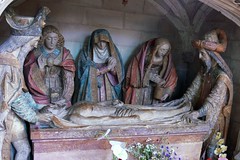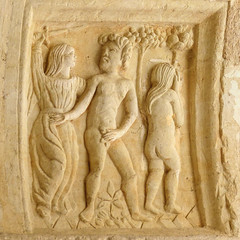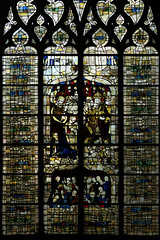 Window 204 consists of two tall lancets forming part of the celebrated early thirteenth-century clerestory glazing of Bourges Cathedral. The saints represented, Andrew on the left and John the Evangelist on the right, are shown as full-height standing figures beneath architectural canopies, framed by the characteristic geometric borders of the Bourges workshop.
Window 204 consists of two tall lancets forming part of the celebrated early thirteenth-century clerestory glazing of Bourges Cathedral. The saints represented, Andrew on the left and John the Evangelist on the right, are shown as full-height standing figures beneath architectural canopies, framed by the characteristic geometric borders of the Bourges workshop.

Window w.206 forms part of the major early 13th-century glazing programme of the choir clerestory at Bourges Cathedral. Like the other apostolic lancets in this zone, it presents three full-length apostles standing beneath architectural canopies, each framed by the characteristic red–blue geometric borders of the Bourges workshop. The style, palette, and facial types align closely with the glazing campaigns dated to c.1210–1215.

Window 208 forms part of the distinguished apostolic cycle that runs around the clerestory of Bourges Cathedral. It presents three standing apostles in individual lancets: St Bartholomew on the left, St Matthew in the centre, and St Simon on the right. Each is set before a deep blue background and surrounded by the richly coloured geometric border characteristic of the Bourges glazing workshop in the early thirteenth century.
Window w.212, located high in the south choir clerestory of Bourges Cathedral, dates from c.1210–1215 and belongs to the earliest glazing phase of the High Gothic choir. The window presents two Evangelists, Mark and Luke, and one Apostle, Matthias.
This trio forms part of a wider apostolic–evangelist cycle distributed around the clerestory, each figure shown as a monumental standing saint set within a richly patterned Gothic frame.
The vast south transept window at Lichfield Cathedral is one of the most imposing works of High Victorian stained glass in the building. Installed between 1869 and 1873 as part of the 19th-century restoration campaign, it was designed and executed by the prolific Gothic Revival studio Clayton & Bell. Comprising nine tall lancets crowned by rich tiers of tracery lights, the window forms a complex yet coherent theological cycle centred on the Majesty of Christ and the ranks of heavenly and ecclesiastical witnesses.
This fresco by Fra Angelico, painted between 1438 and 1443 for the Dominican monastery of San Marco, presents the Baptism of Christ with the clarity, stillness, and devotional intensity characteristic of the artist’s mature period. Set against a serene, winding Jordan River and a stark, mountainous landscape, the composition emphasises the humility of the moment and the contemplative ethos of the monastery for which it was made.
This group of eleven relief panels form part of the carved vault decoration of a sacristy bay at the Royal Abbey of Fontevraud. Executed in a soft, chalky limestone typical of the Loire region, the panels combine biblical narrative scenes with hagiographic episodes from the Life of St Nicholas and include one figure of architectural patronage.
Between 1929 and 1932 the Parisian atelier Mauméjean Frères created a vivid sequence of stained-glass windows for the church of Notre-Dame, Déols. The cycle traces key moments in the lives of the Virgin Mary and Christ, from the Nativity and Annunciation through the Visitation and the miracle at Cana, and finally to the Crucifixion, Resurrection, and the heavenly Coronation of the Virgin.
 This, late 15th–early 16th century, Easter Sepulchre group depicts the moment of Christ’s entombment, a subject traditionally shown in Holy Week rituals in northern France and the Low Countries. The scene is arranged beneath a shallow architectural canopy, gathering together the key figures who, according to the Gospels, prepared Christ’s body for burial.
This, late 15th–early 16th century, Easter Sepulchre group depicts the moment of Christ’s entombment, a subject traditionally shown in Holy Week rituals in northern France and the Low Countries. The scene is arranged beneath a shallow architectural canopy, gathering together the key figures who, according to the Gospels, prepared Christ’s body for burial.
This window (c1470), in the Church of Saint-Maclou, preserves fragments of a mid-15th-century Marian cycle, originally illustrating two principal episodes from the end of the Virgin’s earthly life: the Dormition (Death of the Virgin) in the lower register and the Coronation of the Virgin in heaven in the upper register. Although large sections of the original glazing have been lost, the surviving elements remain representative of the high-quality figure painting produced in Rouen around 1470.






